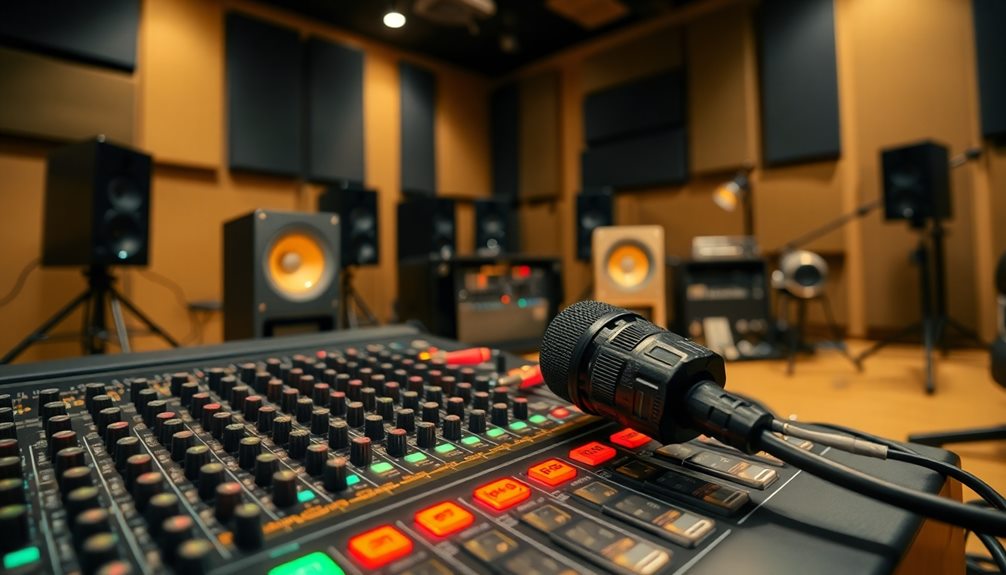Phantom power on a mixer is super important for making condenser microphones work! It provides a needed voltage, usually +48V, through special cables. This power helps the microphone capture sound clearly. While dynamic microphones don't need it, condenser mics rely on phantom power to function properly. You can use both types of microphones at the same time, which is handy! Just remember to check if phantom power is activated, as it helps prevent issues. Knowing about phantom power makes your audio setup better. Want to discover more about how this all works? There's so much more to explore!
Key Takeaways
- Phantom power provides +48V voltage through XLR connectors, essential for powering condenser microphones in audio setups.
- It allows simultaneous use of dynamic and condenser microphones, ensuring flexibility in mixing applications.
- Active DI boxes also utilize phantom power to enhance instrument signal clarity and performance.
- Proper engagement of phantom power is crucial for optimal microphone function and to prevent equipment damage.
- Understanding phantom power improves overall audio quality and simplifies setups by eliminating the need for external power supplies.
Definition of Phantom Power
When you're setting up your audio gear, understanding phantom power is vital. Phantom power is a special type of voltage, usually +48V, needed to power condenser microphones. These microphones have tiny electronics inside that need this power to work. You'll find phantom power supplied through balanced microphone cables, specifically via a three-pin XLR connector.
Here's the cool part: Pins 2 and 3 carry the same voltage, so if you're using dynamic microphones, they won't be affected by phantom power at all! This makes it super convenient.
Modern mixing consoles and audio interfaces often have phantom power built in, which means you don't need to worry about bulky external power supplies.
While +48V is the most common standard, phantom power can range from 9V to 52V. Knowing this is important for audio professionals like you, as it helps prevent equipment damage and guarantees that your audio equipment works well together.
Types of Microphones

Let's explore the different types of microphones you can use, starting with dynamic and condenser mics!
Dynamic microphones are tough and don't need any extra power, making them perfect for live shows.
On the other hand, condenser microphones do need phantom power to work their magic, so it's important to know what you're using for the best sound possible!
Dynamic Microphones Explained
Exploring the world of audio production, dynamic microphones stand out for their reliability and versatility. You'll love that they don't need any external power to operate, unlike condenser microphones that require phantom power. This makes dynamic microphones perfect for various settings, from live performances to studio recordings.
How do they work? Dynamic mics convert sound waves into an audio signal using a diaphragm attached to a coil. When sound hits the diaphragm, it moves within a magnetic field, creating that signal. This process makes dynamic microphones durable and capable of handling loud sounds, making them ideal for booming vocals and powerful instruments.
One of the best features is their ability to isolate sound in noisy environments. Since they're less sensitive to ambient noise, you can focus on the sound you want without distractions.
You'll find different types of dynamic microphones, like handheld vocal mics for singers and instrument mics for musicians. Each type is crafted for specific audio production needs.
In short, dynamic microphones are a fantastic choice for anyone looking to capture high-quality sound without the hassle of additional equipment.
Condenser Microphones Overview
Dynamic microphones are great for many situations, but if you're looking for a different sonic quality, condenser microphones might be what you need. These mics are super sensitive and capture sound with incredible detail. They've a special part called a diaphragm/backplate assembly that turns sound waves into electrical signals, making your recordings sound rich and clear.
One important thing to know about condenser microphones is that they need external power to work. This is usually supplied through phantom power, which gives them a voltage range of 9-52V. Without this power, they won't perform well at all!
While some condenser mics can use internal batteries or other power supplies, phantom power is often the best choice because it's practical and reliable.
When using condenser microphones, it's crucial to connect them to the right phantom power source. This guarantees that the preamp, which boosts the microphone's signal, gets the power it needs. Understanding these power requirements will help you set up your equipment correctly and keep it safe.
Functionality of Phantom Power
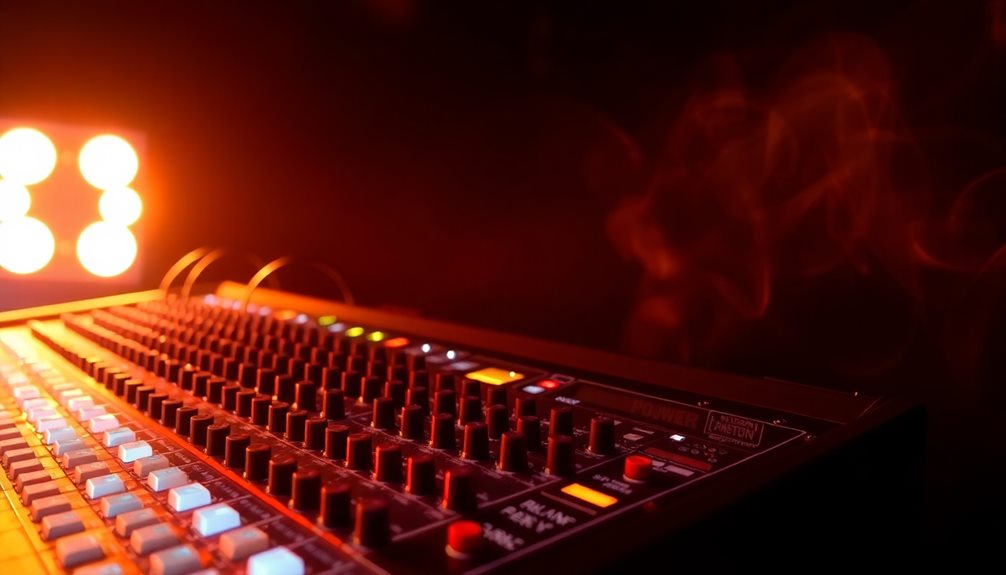
Phantom power's functionality is crucial for the operation of condenser microphones, as it supplies the necessary DC voltage—typically +48V—through balanced microphone cables. This voltage is delivered via three-conductor balanced XLR connectors. Pins 2 and 3 carry equal voltage, which means no current flows to dynamic microphones. This is great because it guarantees they won't get damaged.
Condenser microphones need this phantom power to work properly. It helps polarize the diaphragm and powers the internal preamplifier, which is fundamental for amplifying the sound signal. Without this power, your condenser mic wouldn't pick up sound very well at all!
You'll often find phantom power on mixing consoles and audio interfaces. Most of the time, you can easily toggle it on or off for individual channels, giving you flexibility in your microphone setups.
However, it's super important to use phantom power correctly. If you accidentally apply it to ribbon microphones or other devices that can't handle it, you might damage your equipment. So, always be careful!
Understanding phantom power helps you get the best sound from your condenser microphones. Enjoy making music!
Troubleshooting Microphone Issues
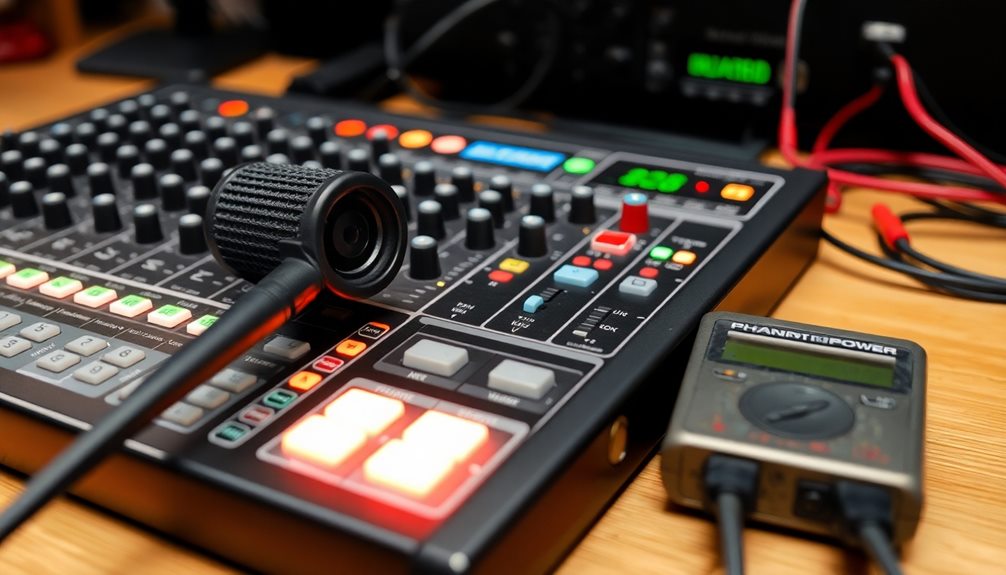
When troubleshooting microphone issues, it's essential to first check if phantom power is activated, especially for condenser microphones. These special mics need phantom power to work properly. If your mic isn't performing, you mightn't have this feature turned on!
Next, take a look at your audio interfaces. Some older models may not provide enough voltage, even when phantom power is on. This can lead to frustrating performance issues. Be sure to consult your device manuals to find out how to toggle phantom power on or off. Some mixers and interfaces have specific controls just for this!
Don't forget, misdiagnosing microphone failure can happen if you overlook phantom power settings. If you're using a new condenser microphone, make sure it's in a setup with proper power.
Lastly, remember to regularly check phantom power status. If you turn it on after connecting the microphone, it could create loud pops or even damage your sensitive equipment.
Additional Support and Resources
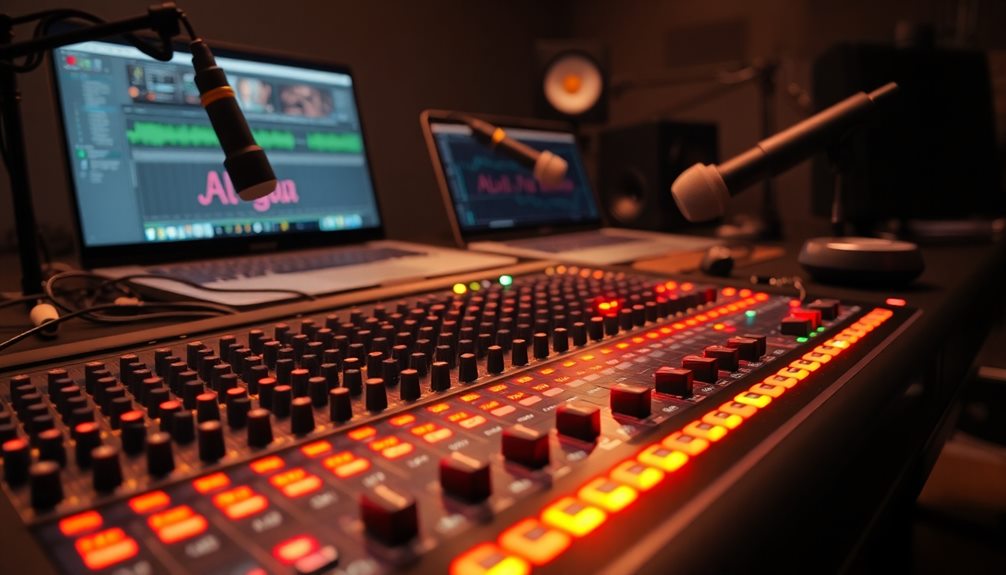
If you're curious about phantom power and how to set up your microphone, reaching out to the Audio Solutions Team is a great first step!
They're super helpful and can guide you through any questions you have.
Plus, checking your device manuals and exploring Sweetwater's knowledge base can really boost your understanding and keep your audio setup running smoothly!
Contact Audio Solutions Team
For any questions or concerns about phantom power in your audio setup, reaching out to the Audio Solutions Team is your best bet. They're ready to help you understand how phantom power works, especially with condenser microphones. If you're having issues like no sound from your microphone, the team can troubleshoot common problems and guide you through the process.
Here's a quick look at what the Audio Solutions Team offers:
| Service | Description |
|---|---|
| Expert Assistance | Get answers about phantom power and its use. |
| Troubleshooting Support | Help with issues like absent phantom power. |
| Additional Resources | Access articles on microphone types and care. |
Don't forget to check your owner's manual for specific details about your gear. This can be super helpful, too! The Audio Solutions Team wants you to succeed with your audio projects, so don't hesitate to reach out. They're excited to provide the support you need to make your audio experience enjoyable and successful.
Consult Device Manuals
Device manuals are invaluable resources that provide essential information about your mixer's phantom power capabilities. When you're immersing yourself in the world of audio mixing, these manuals help you understand how to use phantom power supplies effectively.
You'll discover whether phantom power can be toggled on or off, and which channels need it. Some mixers even have dedicated phantom power buttons for individual channels!
It's also super important to check the voltage specifications in the manual. Most mixers deliver around 48 volts, but this can vary. Knowing the right voltage guarantees your microphone works correctly.
Speaking of microphones, the manual will tell you about compatible microphone types. Using the wrong mic can lead to problems, so don't skip this part!
Lastly, manuals often include troubleshooting sections. If you run into issues, these sections can help you diagnose connectivity problems with your mic.
Explore Knowledge Base Resources
Frequently, users overlook the wealth of information available in knowledge base resources when setting up phantom power on mixers.
These resources can be your best friend! They offer detailed insights on how to use phantom power effectively with your condenser microphones.
The Audio Solutions Department is also there to help with any questions you might have. They can guide you through the mixer setup and explain the specific power needs of different microphones.
Knowing these details can really enhance your audio performance.
Don't forget to check your device manual! It often includes key details about your mixer's phantom power capabilities, which can help you troubleshoot any problems.
Sweetwater's extensive knowledge base is another fantastic resource.
You'll find articles about various microphone types, how to care for them, and their functionality. This information will deepen your understanding of phantom power and its importance in audio setups.
Importance of Phantom Power
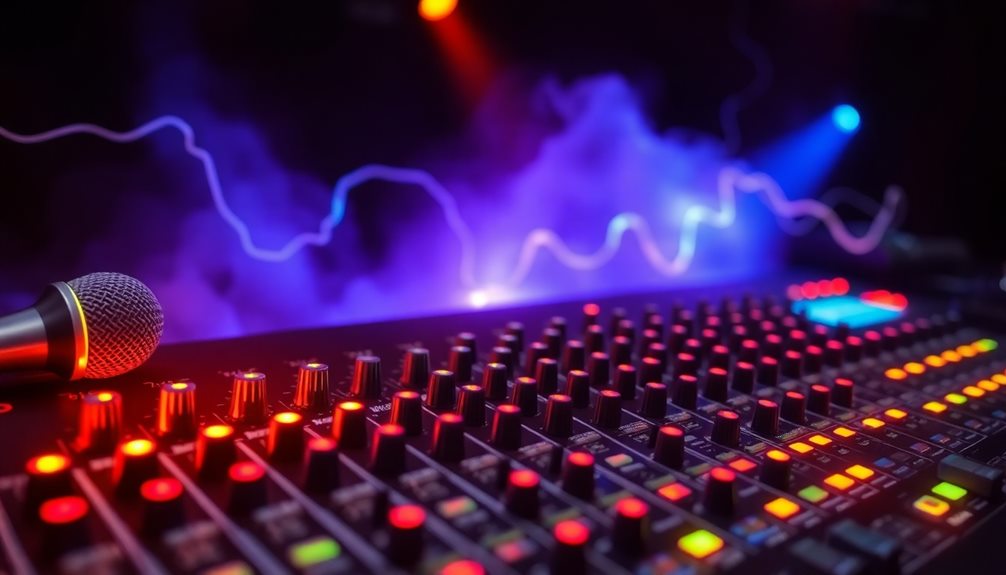
Understanding the importance of phantom power is crucial for anyone working with audio equipment, especially in the domain of professional sound.
Phantom power provides the necessary DC voltage, usually +48V, that condenser microphones need to operate. These microphones rely on external power for their internal preamps and polarization charge.
By using phantom power, you can eliminate the bulky external power supplies, simplifying your audio setup. This is especially helpful in live sound environments and recording studios, where space is often limited.
When you engage phantom power properly, it guarantees the best performance from your microphones.
However, be cautious! Ribbon microphones can be sensitive and may get damaged if phantom power is accidentally turned on.
Many modern mixing consoles let you toggle phantom power for individual channels. This means you can choose which microphones to power, making your setup even more flexible.
Applications of Phantom Power

Phantom power is super important for powering condenser microphones, which need a little boost to work their magic.
It also helps active DI boxes do their job, making sure your sound is clear and strong.
Just remember, if you're using a ribbon microphone, you'll want to be careful, since they can get hurt by too much power!
Powering Condenser Microphones
Condenser microphones are heavily reliant on phantom power to operate effectively, typically needing +48V for ideal performance. This special power comes directly from your mixing console or audio interface through balanced XLR-type connectors. Isn't that neat? You don't have to worry about bulky external power sources!
Phantom power charges the microphone's diaphragm and powers its internal preamps. This makes it possible for the microphone to convert sound waves into clear electrical signals. When you speak or sing into a condenser microphone, you'll notice how crisp and vibrant your voice sounds!
While dynamic microphones don't need phantom power to work, they're totally fine with it. This means you can use both types of microphones at the same time without any issues. Just make certain to turn on the phantom power for the condenser microphone channel on your mixer.
Most modern mixers have handy switches that let you toggle phantom power on or off for each channel. This way, you can ascertain everything is compatible, and you get the best sound for your recordings.
Active DI Box Functionality
When you're working with instruments like guitars or keyboards, an active DI box becomes invaluable. These cool devices use phantom power to boost your instrument's signal, making it easier to connect to mixing consoles and audio interfaces. This means you get a clearer sound!
Active DI boxes convert high-impedance signals from your instruments into low-impedance signals. This is super important for maintaining signal integrity, especially over long cable runs. Plus, they often get their phantom power straight from the mixer, so you won't need extra power supplies.
Here's a quick look at the benefits of using an active DI box:
| Feature | Description | Benefit |
|---|---|---|
| Phantom Power | Powers internal circuitry | Boosts signal for better sound |
| Signal Integrity | Maintains audio quality over distance | Clearer sound without loss |
| High-Impedance Input | Converts instrument signals to low-impedance | Compatibility with gear |
Many active DI boxes even let you toggle phantom power on or off, so you can use them with various microphones and instruments. They're essential for both live sound and studio work, ensuring you always get the best audio quality!
Ribbon Microphone Considerations
How can you guarantee your ribbon microphone performs at its best? First, you need to understand how phantom power works with ribbon microphones. If you're using an active ribbon mic, it might need phantom power to function properly.
However, if your mic is a passive ribbon mic, you shouldn't connect it to phantom power at all! Doing so can cause serious damage, like stretching or even breaking the delicate ribbon inside, leading to microphone failure.
To avoid mishaps, always check the specifications of your ribbon microphones before using them with phantom power. This step guarantees compatibility and protects your gear.
Many mixing consoles have dedicated switches for phantom power on each channel. This feature lets you enable phantom power only for the microphones that need it, keeping your passive ribbon mics safe.
In professional audio setups, isolating phantom power for specific channels is key. It helps maintain the integrity of your ribbon microphones while allowing you to use other powered mics on different channels.
Historical Context of Phantom Power
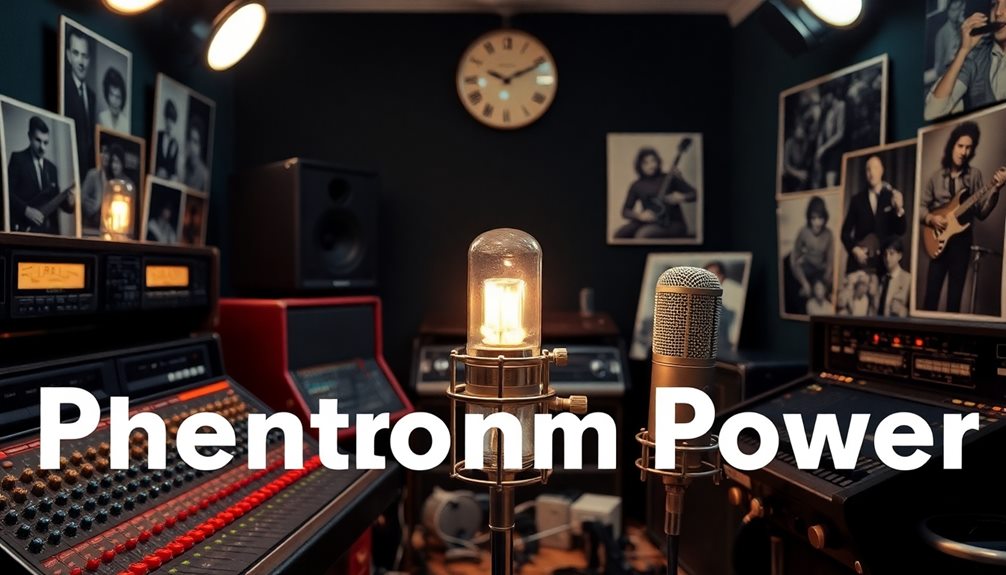
Phantom power's intriguing history traces back to the early 1900s, when it first emerged as a solution for powering transistors and diode lights. This innovation laid the groundwork for powering audio equipment in the future.
Fast forward to 1966, when the Neumann Company introduced the KM84, the first transistorized microphone using phantom power. It cleverly utilized the existing 48V power from radio studio transmission cables.
Over time, the standard voltage for phantom power was established at 48V, which quickly became the industry norm for powering condenser microphones. This meant that sound engineers could use these microphones without needing bulky external power supplies. Isn't that amazing?
Phantom power's evolution has notably influenced modern audio technology. It's allowed for more compact and efficient audio setups, making it easier for musicians and producers like you to create high-quality recordings.
Today, condenser microphones are everywhere, from studios to live performances, and they owe a lot to this fascinating history. Understanding how phantom power works can help you appreciate the technology behind the music you love.
Signal Integrity and Functionality
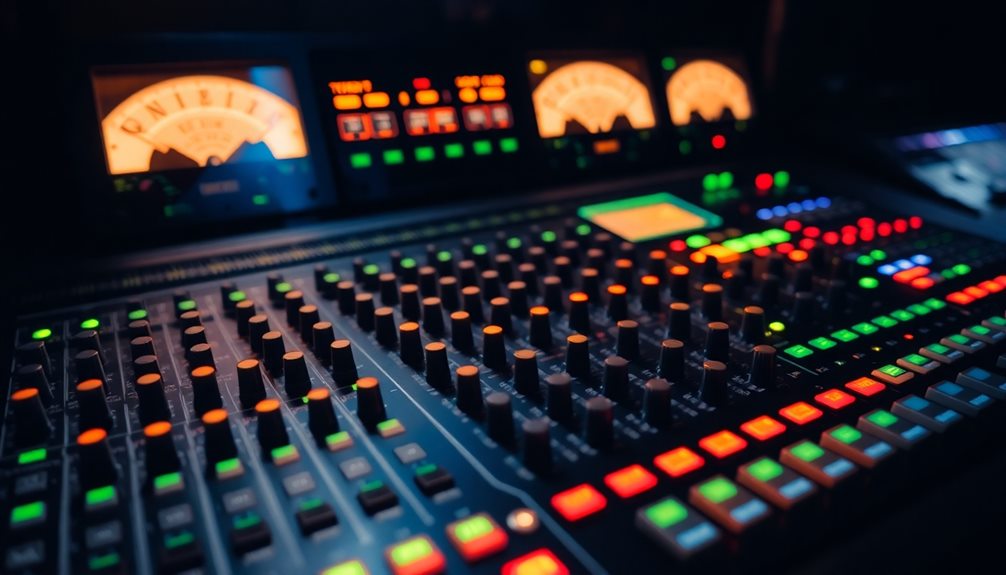
Understanding the historical significance of phantom power sets the stage for appreciating its role in maintaining signal integrity and functionality in modern audio systems.
Phantom power is essential, especially for condenser microphones, which require a voltage difference to operate effectively. Typically set at +48V, this power flows through balanced microphone cables. These cables guarantee that the voltage is the same on both the positive and negative wires, creating a balanced system that prevents unwanted currents from affecting dynamic microphones.
When you engage phantom power, it doesn't interfere with the audio signals. Instead, it enhances signal integrity by supplying the necessary voltage to condenser microphones. This allows them to convert sound into electrical signals without degrading the audio quality.
The XLR connectors used for phantom power have three pins—one for ground and two for the audio signals. This design enables the simultaneous delivery of power and audio, making it efficient.
With properly implemented phantom power and balanced circuits, you can eliminate noise and maintain clarity in your audio systems. So, when you set up your mixer, remember that phantom power is your friend in achieving great sound!
Safety and Practical Considerations
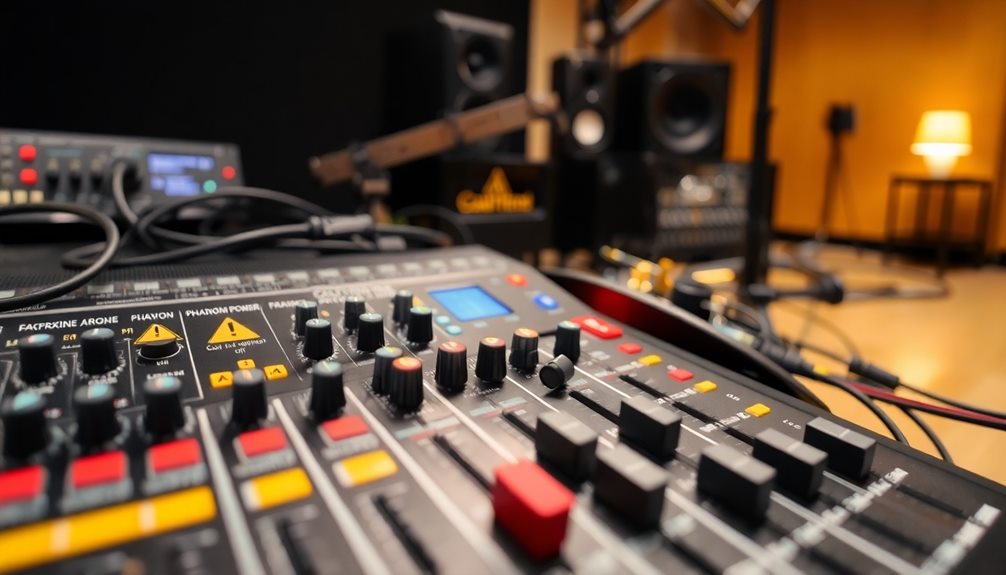
When using phantom power, it's crucial to prioritize safety and compatibility to guarantee your audio setup operates smoothly. Phantom power, usually delivering +48V, is safe for user operation when used correctly.
You'll love how it powers your condenser microphones, which need that extra boost to perform their best. But be careful! If you're using a ribbon microphone, phantom power can cause damage to these delicate devices, so always check device specifications before connecting anything.
Most modern home studio gear is designed to power all microphone inputs at the same time. This makes setting up your audio equipment a breeze! Just make sure to confirm that everything is compatible.
Understanding phantom power helps you use your gear effectively, leading to amazing audio quality and preventing any mishaps.
Frequently Asked Questions
What Does Phantom Power Do on a Mixer?
Phantom power supplies the necessary voltage for condenser microphones to function properly. When activated on your mixer, it enables these mics to convert sound into electrical signals, enhancing audio quality without affecting dynamic microphones.
How Do You Know When to Use Phantom Power?
You know to use phantom power when connecting condenser microphones, as they need external voltage to function. Always check your mixer's manual, guarantee devices are connected, and avoid using it with ribbon microphones to prevent damage.
Can Phantom Power Damage a Mixer?
Phantom power won't damage your mixer; it's built to handle it. Just make sure you connect compatible microphones, as improper connections could harm the mic instead. Always check your mixer's manual for guidance.
Does Phantom Power Improve Sound Quality?
Imagine a car running on low fuel; it won't perform well. Phantom power doesn't directly improve sound quality, but it guarantees your condenser mic operates at peak performance, capturing clearer audio and enhancing your recordings.
Conclusion
In the world of sound, phantom power is like a superhero for your microphones! It gives them the energy they need to shine and deliver crystal-clear audio. Now that you know what phantom power is and how it works, you're ready to tackle any audio adventure. Whether you're recording a song or capturing a podcast, understanding this magic will make your sound sparkle. So plug in, power up, and let your creativity soar!
